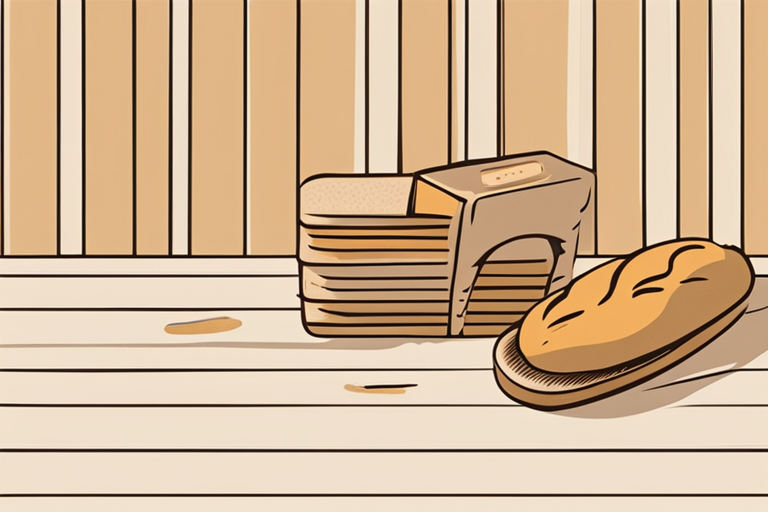
How Long is Bread Good for After the Expiration Date
Get Your Free Food Safety Cheat Sheet
30 most common foods with instant answers. Print it and stick it on your fridge—completely free!
# How Long is Bread Good for After the Expiration Date
In our busy lives, it's easy to overlook the expiration dates on our food items, including bread. But what happens when you find a loaf of bread past its expiration date? Is it still safe to eat? In this blog post, we'll explore how long bread is good for after the expiration date, and provide you with practical tips on how to ensure your bread stays fresh and safe to eat.
## Understanding Bread Expiration Dates
When you purchase a loaf of bread from the store, you'll notice that it comes with a printed expiration date. This date is determined by the manufacturer based on factors like the ingredients used, the packaging, and storage conditions. It's important to note that the expiration date is an estimate of how long the bread will stay fresh and flavorful, but it doesn't necessarily mean the bread is unsafe to eat after that date.
### Factors Affecting Bread Shelf Life
Several factors can influence how long bread stays fresh after the expiration date. These include:
- **Ingredients**: Bread made with preservatives tends to have a longer shelf life.
- **Packaging**: Properly sealed packaging can help extend the shelf life of bread.
- **Storage**: Storing bread in a cool, dry place can prevent mold growth and extend its freshness.
- **Humidity**: High humidity can cause bread to become stale or moldy more quickly.
## How Long is Bread Good for After Expiration Date?
While it's always best to follow the manufacturer's guidelines, in general, bread can still be safe to eat for some time after the expiration date. Here's a general guideline on how long different types of bread can last after the expiration date:
### Sliced Bread
- **White bread**: 5-7 days
- **Whole wheat bread**: 7-9 days
- **Multigrain bread**: 7-9 days
### Artisan Bread
- **Baguette**: 2-3 days
- **Sourdough**: 5-7 days
- **Ciabatta**: 3-5 days
### Tips for Checking Bread's Freshness
To determine if bread is still good to eat after the expiration date, consider the following:
1. **Visual Inspection**: Check for mold growth, discoloration, or an off smell.
2. **Texture Test**: Squeeze the bread gently to see if it's still soft and springy.
3. **Taste Test**: If the bread passes the visual and texture test, give it a taste to ensure it hasn't gone stale.
## Real-Life Scenarios
Sometimes, life throws unexpected situations our way that leave us wondering about the safety of our food. For instance, imagine it's a Sunday morning, and you have friends over for brunch. You planned on making delicious French toast, but when you reach for the loaf of bread in the back of your pantry, you notice it's a week past its expiration date.
In this case, pausing to check for mold or any strange odors could save the day. If the bread seems fine, you could make that brunch a memorable one without needing to run out to the store!
Another relatable scenario: After a busy week, you might find a forgotten half-eaten bag of artisan bread at the back of your fridge. A quick inspection reveals it’s just a few days past the expiration date. Instead of tossing it out, you could repurpose it into croutons or bread pudding, giving it a second life while reducing food waste.
### A Family Gathering Gone Right
Picture this: You’re hosting a family gathering, and you’ve decided to prepare a hearty sandwich platter. As you rummage through the pantry, you stumble across a loaf of rye bread that’s a bit past its expiration date. Instead of panic, you conduct a quick freshness test. The bread looks good and smells just fine. You decide to use it, and your guests rave about the sandwiches! This not only saves you a trip to the store but also surprises everyone with a delightful flavor they didn’t expect from a “past due” loaf.
### The Unexpected Bread Bake
Imagine a rainy afternoon where you find an old loaf of bread that’s a couple of days past its expiration date. Normally, you would toss it, but today you’re feeling a little adventurous. You decide to turn that bread into a delicious homemade bread pudding. With a bit of custard, cinnamon, and raisins, what started as a potential waste transforms into a warm, comforting dessert that everyone enjoys. It’s amazing what creativity can do!
## Storing Bread for Extended Freshness
Proper storage is key to extending the shelf life of bread and keeping it safe to eat. Here are some tips for storing bread to maintain its freshness:
- **Room Temperature**: Store bread in a cool, dry place away from direct sunlight.
- **Refrigeration**: While refrigeration can extend the life of some bread, it can also cause bread to go stale faster.
- **Freezing**: To keep bread fresh for longer periods, consider freezing it in airtight bags or containers.
### Freezing Bread Tips
- **Slice Before Freezing**: Slice the bread before freezing to make it easier to thaw individual portions.
- **Thawing**: Allow frozen bread to thaw at room temperature or in the refrigerator for best results.
### Innovative Storage Solutions
To further enhance your bread storage, consider using bread boxes made from natural materials like wood or bamboo. These boxes provide optimal airflow while still protecting the bread from environmental factors that contribute to spoilage.
Additionally, if you find yourself frequently with extra bread, investing in a vacuum sealer can be beneficial. By removing air, you can significantly prolong the freshness of your bread, allowing you to enjoy it at your leisure without the worry of waste.
## Safety Warnings
While bread can often be consumed after its expiration date, there are important safety considerations to keep in mind. If you notice any signs of mold, it’s crucial to discard the entire loaf. Mold can sometimes appear in forms that are not visible to the naked eye, and consuming moldy bread can cause allergic reactions or other health issues. In addition, if the bread has an unpleasant or sour smell, it’s best to err on the side of caution and throw it out.
Also, be aware that if you've stored bread in an environment that's too warm or humid, it may spoil more quickly than expected. Always trust your instincts; if something seems off, it's safer to discard it.
### The Dangers of Mold
Many people don’t realize that mold can produce mycotoxins, which are harmful substances that can cause serious stomach issues if ingested. Even if you cut away the visibly moldy part, the mycotoxins can still be present in the remaining bread. This is particularly important to remember with breads that contain whole grains or nuts, as they can be more prone to mold growth.
## Common Mistakes
Many people don't realize that storing bread in the fridge can actually lead to a faster staling process due to the cool temperatures. While it might seem like a good idea to keep it longer, the fridge’s humidity can affect the texture and flavor negatively. Another common mistake is leaving bread in its original packaging, which might not be airtight. Instead, consider transferring it to a sealed container or bag to maintain freshness.
### Ignoring the Importance of Bread Type
Another common mistake is treating all types of bread the same. For instance, artisan breads often have a different texture and moisture content compared to store-bought loaves, making them more susceptible to staling or mold. Knowing the right storage method for each type can help you enjoy your bread at its best!
## Scientific Context
Understanding the science behind bread preservation can also help you make better choices. The primary reason bread goes stale is due to a process called retrogradation, where the starches in the bread crystallize as they cool, causing the bread to lose its softness. Storing bread at room temperature slows down this process, while freezing can halt it altogether.
Moreover, additives like calcium propionate and ascorbic acid are often included in commercially-produced bread to inhibit mold growth and extend shelf life. These preservatives play a vital role in maintaining bread quality during storage.
### The Role of Yeast
Another interesting aspect of bread is the role of yeast in its preservation. Yeast ferments sugars in the dough, creating carbon dioxide that causes bread to rise. The fermentation process also impacts the bread's flavor and texture. When bread is properly baked, it creates a crust that helps to seal in moisture and inhibit mold growth. Understanding this process can help you appreciate why freshness is important!
## Expert Insights
Professional food safety experts recommend regularly checking your pantry and fridge for expired products. Keeping a rotating system—where you use older products first—can help minimize waste. Additionally, if you purchase bread in bulk, consider sharing with friends or neighbors to ensure that nothing goes to waste.
When in doubt, consult resources such as the USDA’s Food Safety and Inspection Service, which offers guidelines not just for bread but for all food safety concerns. They also emphasize the importance of reading labels and understanding what different dates mean, ranging from "sell by" to "use by."
### Engaging with Local Bakeries
Another tip from experts is to engage with your local bakeries. Fresh bread from local sources often lacks preservatives, meaning it might have a shorter shelf life but a much richer flavor. Many bakeries will provide advice on how to store their products optimally, so don’t hesitate to ask!
## Conclusion
In conclusion, while it's important to be mindful of expiration dates, bread can still be safe to eat for some time after the date has passed. By understanding the factors that affect bread's shelf life, conducting simple freshness tests, and storing bread properly, you can enjoy your favorite loaves for longer periods. Remember to trust your senses when determining if bread is still good to eat, and when in doubt, it's best to err on the side of caution. Enjoy your bread and stay safe!

Authoritative Food Safety References
These agencies and university labs inform every tip and health precaution we publish.
USDA FoodKeeper – Cold Storage Guidelines
Official refrigerator, freezer, and pantry timelines maintained by the U.S. Department of Agriculture.
Visit USDA FoodKeeperFDA Produce Safety Rule & Grower Guidance
Field-to-fridge handling practices that prevent contamination of fruits, vegetables, and leafy greens.
Visit FDA Produce SafetyCDC Foodborne Illness Prevention Hub
Surveillance-backed guidance on pathogens, symptoms, and steps to reduce foodborne illness risk.
Visit CDC Food SafetyUC Davis Postharvest Technology Center
University research detailing optimal storage atmospheres for produce after harvest.
Visit UC Davis PostharvestPenn State Extension – Home Food Preservation & Safety
Peer-reviewed extension bulletins on safe canning, chilling, and reheating practices.
Visit Penn State ExtensionCan you freeze bread to extend its shelf life?
How should bread be stored to keep it fresh?
What are the signs that bread has gone bad?
Can you still use bread that is past its expiration date for toast or breadcrumbs?
Get Your Free Food Safety Cheat Sheet
30 most common foods with instant answers. Print it and stick it on your fridge—completely free! Want more? Upgrade to the complete guide with 70+ foods.
Scan your food directly and get instant safety info using our AI-powered camera feature.